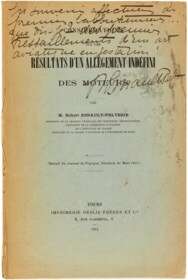ID 369995
Lot 6 | Space travel is possible: the theoretical proof
Estimate value
£ 4 000 – 7 000
Considérations sur les Résultats d’un Allègement indéfini des Moteurs. [Offprint from: Journal de Physique théorique et appliqué, Cinquième Série, Tome III]. Tours: Deslin Frères, 1913.
Octavo (240 x 165mm). Original printed wrappers (extremities a little frayed). Provenance: Esnault-Pelterie (presentation inscription on front wrapper: ‘En souvenir affectueux des premiers balbutiements … que dis-je ? des premiers tressaillements d’un art aviatique en gestation!’ (‘In affectionate memory of the first stutterings … what am I saying? The first thrummings of an aviation art in gestation!’).
First edition, presentation copy of the exceptionally rare separately-paginated offprint – the text that set out the demonstration that space travel is possible. This was the published version of the lecture delivered by Esnault-Pelterie in 1912 in St Petersburg and Paris, marking the beginning of theoretical astronautics. ‘The lecture contains all the theoretical bases of self-propulsion, destroying the myth that rockets need atmospheric support and giving the real equation of motion. Anticipated is the use of auxiliary propulsion for guidance and complete maneuverability of rockets. Also contained are calculations of the escape velocity, the phases of a round-trip voyage to the Moon, and the times, velocities, and durations, of trips to the Moon, Mars, and Venus, as well as thermal problems related notably to the surface facing the sun . . . This 1912 lecture is the first purely scientific study marking the birth of astronautics. While Tsiolkovsky had the prescience and talent to first suggest, in 1903, rocket propulsion to space, REP [as Esnault-Pelterie liked to be called] was the first to develop the equations of the problem and to establish the mathematical theory of interplanetary flight. REP is thus the founder of theoretical astronautics’ (Blosset, ‘Robert Esnault-Pelterie: Space pioneer’, in Durant & James, First Steps toward Space, 1974, p. 9).
Esnault-Pelterie’s lecture appeared in print in the Journal de Physique théorique et appliqué in abridged form, due to both space considerations and the trepidations of the journal’s editor, who was shocked by Esnault-Pelterie’s ideas on space travel – up to that point the exclusive realm of science fiction. Indeed Esnault-Pelterie’s paper was far ahead of its time, and failed to stir the public interest. His conclusions did, however, have a significant influence on other rocketry pioneers. This paper ‘was very likely the catalyst that spurred [Robert H. Goddard, America’s future rocket scientist] to present his work publicly as a patent, through lectures, and in published form. … For some Russians Esnault-Pelterie remained a focus of interest, the true pioneer. His rocket calculations set a standard. … It was the French, wrote N. Tolstoi, who were allowing humanity to ‘step over the boundaries’ between fantasy and reality with their project for a navigable ‘spacecraft’ … All that interplanetary travel needed was to apply the sciences of physics and orbital mechanics to the task, in the manner of Esnault-Pelterie' (Smith, Rockets and Revolution: A Cultural History of Early Spaceflight, 2014, pp. 82-83). OCLC lists a single copy of this offprint (Bibliothèque Nationale de France).
| Category: | Autographs and letters |
|---|
| Category: | Autographs and letters |
|---|
| Address of auction |
CHRISTIE'S 8 King Street, St. James's SW1Y 6QT London United Kingdom | |
|---|---|---|
| Preview |
| |
| Phone | +44 (0)20 7839 9060 | |
| Buyer Premium | see on Website | |
| Conditions of purchase | Conditions of purchase |



